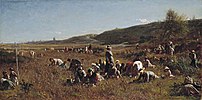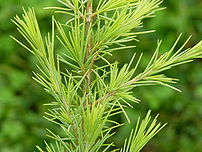
Botanical Name:Vaccinium macrocarpon
Family:Ericaceae
Kingdom: Plantae
Division: Magnoliophyta
Class: Magnoliopsida
Order: Ericales
Genus: Vaccinium
Subgenus: Oxycoccos
Other names: North American cranberry, large cranberry
Parts Used: The ripe fruit of the cranberry is the part used in commercial and medicinal preparations
Habitat:Cranberries mainly thrive in sandy soil and bogs. They are mainly seen in the regions between Newfoundland, down to North Carolina, and also westwards to Minnesota. In terms of production, the state that produces the most cranberries in the US is Wisconsin, while Massachusetts comes a close second. Massachusetts alone produces about 2 million barrels of cranberries annually!
Description:
Cranberries are low, creeping shrubs or vines up to 2 m long and 5 to 20 cm in height; they have slender, wiry stems that are not thickly woody and have small evergreen leaves. The flowers are dark pink, with very distinct reflexed petals, leaving the style and stamens fully exposed and pointing forward. They are pollinated by domestic honey bees. The fruit is an epigynous berry that is larger than the leaves of the plant; it is initially white, but turns a deep red when fully ripe. It is edible, with an acidic taste that can overwhelm its sweetness.
click to see the pictures..>….(01)...(1).…..(2).……..(3)…….(4)....
The cranberry plant–-called a vine by growers–is a long-lived perennial less than eight inches high with trailing, thin, wiry stems that bear small, opposite, evergreen leaves. Cranberry flowers appear around the Fourth of July; these are white to light pink, downward-pointing, bell-shaped, axillary flowers. The common name cranberry is a modification of the colonial name “crane berry,” because the drooping flower looked like the neck and head of the sand crane, which was often seen eating the fruits.
Cranberries are a major commercial crop in certain American states and Canadian provinces (see “Cultivation and Uses” below). Most cranberries are processed into products such as juice, sauce, and sweetened dried cranberries, with the remainder sold fresh to consumers. Cranberry sauce is regarded an indispensable part of traditional American and Canadian Thanksgiving menus and European winter festivals.
Since the early 21st century within the global functional food industry, there has been a rapidly growing recognition of cranberries for their consumer product popularity, nutrient content and antioxidant qualities, giving them commercial status as a novel “superfruit”.
Species:
There are three to four species of cranberry, classified in two sections:
*Subgenus Oxycoccos, sect. Oxycoccos
*Vaccinium oxycoccos or Oxycoccos palustris (Common Cranberry or Northern Cranberry) is widespread throughout the cool temperate Northern Hemisphere, including northern Europe, northern Asia and northern North America. It has small 5-10 mm leaves. The flowers are dark pink, with a purple central spike, produced on finely hairy stems. The fruit is a small pale pink berry, with a refreshing sharp acidic flavour.
*Vaccinium microcarpum or Oxycoccos microcarpus (Small Cranberry) occurs in northern Europe and northern Asia, and differs from V. oxycoccus in the leaves being more triangular, and the flower stems hairless. Some botanists include it within V. oxycoccos.
*Vaccinium macrocarpon or Oxycoccos macrocarpus (Large cranberry, American Cranberry, Bearberry) native to northeastern North America (eastern Canada, and eastern United States, south to North Carolina at high altitudes). It differs from V. oxycoccus in the leaves being larger, 10-20 mm long, and in its slightly apple-like taste.
Subgenus Oxycoccos, sect. Oxycoccoides
Vaccinium erythrocarpum or Oxycoccos erythrocarpus (Southern Mountain Cranberry) native to southeastern North America at high altitudes in the southern Appalachian Mountains, and also in eastern Asia.
Chemical Composition of Cranberries
Basically, cranberries have a very rich chemical composition. They are formed chemically of triterpinoids, a range of acids, such as benzoic acid, citric acid, malic acid, quinic acid, ascorbic acid, leptosine glycosides, glucuornic acid, catechin, as well as alkaloids and anthocyanin dyes. The different combinations of these are what provide the rich variety of medicinal benefits associated with cranberries.
Phytochemicals: The cranberry contains Catechins, Triterpenoids, Quinic Acid, Hippuric Acid, Anthocyanins
Medicinal Uses and Indications
Urinary tract infections
Cranberry is used to prevent urinary tract infections of the bladder and urethra (the tube that drains urine from the bladder). Several studies indicate its effectiveness. In one study of older women, cranberry juice significantly reduced the amount of bacteria present in the bladder compared to placebo. Another study showed that younger women with a history of recurrent UTIs who took cranberry by capsule significantly reduced the recurrence of UTI compared to those who took placebo.
However, evidence suggests that cranberry is not as effective against bacteria once they have attached to cells in the urinary tract. For this reason, cranberry is more effective at preventing UTIs than treating them. Instead, UTIs should be treated with conventional antibiotics.
Ulcers
A preliminary study suggests that cranberry may also prevent the bacteria Helicobacter pylori from attaching to stomach walls. H. pylori can cause stomach ulcers, so it is possible that cranberries may eventually prove to play a role in the prevention of this condition. However, more research is needed.
Heart disease
The antioxidants found in cranberry may protect from heart disease by lowering LDL (“bad”) cholesterol, relaxing blood vessels, and preventing plaque from building up in arteries. However, more research is needed.
Cancer
In some test tube studies, cranberry appears to inhibit the growth of cancer cells. It is too early to say whether the herb will have the same effect in humans.
Oral hygiene
Studies also suggest that cranberries may help prevent bacteria from adhering to gums and around the teeth, helping to prevent cavities. Researchers caution, however, that cranberry juice is often high in sugar and should not be used for oral hygiene.
Available Forms
Cranberries are available fresh or frozen and in juice and concentrate forms. Dried berries are also available in tablet or capsule form. Pure cranberry juice is very sour, so most cranberry juices contain a mixture of cranberries, sweeteners (which may reduce the healthful effects of the juice), and vitamin C. Look for a brand of cranberry juice that has the lowest amount of added sugar or is sugar-free.
How to Take It
Pediatric
There is not enough evidence to establish a safe dose for children prone to UTIs. A child with a UTI should be under the care of a qualified health care provider.
Adult
Juice: 3 or more fluid oz. of pure juice per day, or about 10 oz. of cranberry juice cocktail
Capsules: 300 mg to 400 mg, 6 per day in divided doses
Fresh or frozen cranberries: 1.5 ounces
Precautions:
The use of herbs is a time-honored approach to strengthening the body and treating disease. Herbs, however, can trigger side effects and can interact with other herbs, supplements, or medications. For these reasons, herbs should be taken with care, under the supervision of a healthcare practitioner.
Cranberry juice and supplements are generally considered safe with no serious side effects, even for pregnant women.
Cranberry contains relatively high levels of oxalate, chemicals that may increase the risk of kidney stones. People who have or have had kidney stones should talk to their doctor before taking cranberry supplements or drinking large amounts of cranberry juice.
Cranberry should not be used as a substitute for antibiotics during a UTI.
Because most cranberry juice contains added sugar, people who have diabetes should look for brands of juice that are artificially sweetened or should limit their consumption of regular juice.
Possible Interactions
A preliminary report suggests that cranberry may interfere with the effects of the blood-thinning drug warfarin. If you take warfarin, do not take supplemental cranberry and limit your consumption of cranberry juice.
Research Reviews:
*A flavonoid fraction from cranberry extract inhibits proliferation of human tumor cell lines
*Inhibition of Helicobacter pylori and associated urease by oregano and cranberry phytochemical synergies. *Cranberry for Prevention of Urinary Tract Infections
*What’s the use of cranberry juice?
Abstracts:
*Cranberry and the Urinary Tract
*Anti-Adhesion Properties of Cranberry
*Cranberry and Dental Health
*Cranberry and Stomach Ulcers
*Influence of Cranberry on Heart Disease
*Anti-Cancer Properties of Cranberry Phytochemicals
*Phytochemicals in Cranberry
Click to see :->How Cranberries Grow
Americans Discover the Bacteria-Blocking Properties of Cranberries
Disclaimer:The information presented herein is intended for educational purposes only. Individual results may vary, and before using any supplements, it is always advisable to consult with your own health care provider.
Resources:
http://www.botgard.ucla.edu/html/botanytextbooks/economicbotany/Vaccinium/index.html
http://www.furtherhealth.com/article/54_2_Cranberry-Facts/
http://www.umm.edu/altmed/articles/cranberry-000235.htm#Medicinal%20Uses%20and%20Indications
http://www.phytochemicals.info/plants/cranberry.php



![Reblog this post [with Zemanta]](https://i0.wp.com/img.zemanta.com/reblog_e.png?w=580)







































